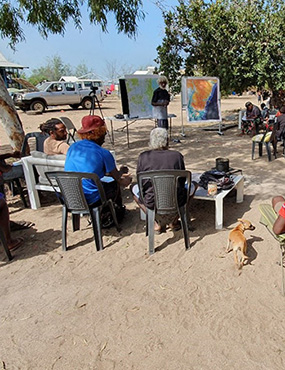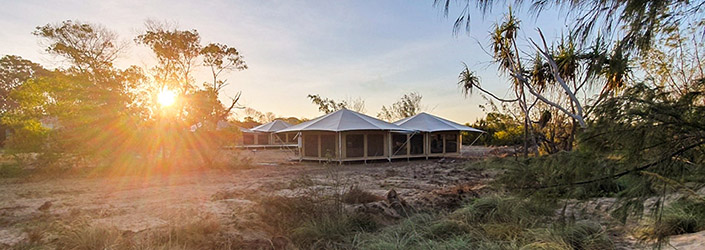Including indigenous knowledge in conservation plans
Macquarie’s cross-cultural ecology lab works with Indigenous communities in Arnhem Land, northern NSW and across eastern Australia to co-create research on environmental issues.

Cross-cultural ecology and education
Inclusion of Indigenous people, knowledge and Country are clearly mandated in international and Australian environmental conservation strategies. In response, cross-cultural approaches to science and conservation that include Indigenous and Western ways of knowing and doing are being developed, with Macquarie University researchers and our Indigenous colleagues leading the way, as demonstrated by the 2018 ERA Engagement-Impact assessment .
Macquarie’s cross-cultural ecology lab works with Indigenous communities in Arnhem Land, northern NSW and across eastern Australia to co-create research on biodiversity, invasive species, wetlands, cultural burning, rainforest tree dispersal, climate change and locally driven monitoring programs.
We strive for inclusive approaches that draw in Indigenous Elders, Rangers and young people to participate in all stages of research from project conceptualization, data collection, data analysis and interpretation and communications. Our commitment to inclusion and cross-cultural capacity building was recognized in the 2017 Eureka Prize for Innovation in Citizen Science.
Ensuring mutual benefits for University and community partners is essential to our work and is highlighted by our collaborative establishment of the Wuyagiba Bush University. The Bush Uni has created a cross-cultural learning pathway for students of eastern Arnhem Land to attend Macquarie University, following requests and leadership from local Elders. This project aims to close the 30 year higher education gap for these remote communities.
Effective environmental management requires the sharing of knowledge, education, capacity, resourcing and inclusion of local land owners and managers in decision-making.
Macquarie University NSW 2109

Dr Emilie Ens
Lab Leader
Macquarie University
Mr Gerry Turpin
Ethnobotanist, Queensland Government
Adjunct Fellow, James Cook University
Dr Maurizio Rossetto
Principal Scientist, Royal Botanic Gardens and Domain Trust Sydney
Dr Philip Clarke
Adjunct Fellow, South Australian Museum
Mr Oliver Costello
Director, Firesticks Initiative
Professor Craig Moritz
Australian National University
NSW Biodiversity Adaptation Hub
MQ — OEH BioNode partnership
Dr Leanne Holt — MQ PVC Indigenous Strategy
Ms Sue Pinckham — MQ Cultural Advisor
Mr Ben Kitchener — MQ Research Officer
MQ HDR Students
Shaina Russell — PhD Student
Michelle McKemey — PhD Student (Base at UNE)
Daniel Sloan — PhD Student
Patrick Cooke — PhD Student
Monica Fahey — PhD Student
Industry partners:
- The Nature Conservancy
- The Atlas of Living Australia
- The Laynhapuy Homelands Association/ Indigenous Protected Area
- The South East Arnhem Land Indigenous Protected Area
- Minyumai Indigenous Protected Area
- Wuyagiba Bush Hub Aboriginal Corporation, OEH
End-users:
- Communities of eastern Arnhem Land including Ngukurr and the Laynhapuy Homelands.
- Arnhem Land communities in the South East Arnhem Land and Laynhapuy Indigenous Protected Areas (IPAs).
- Northern NSW – Minyumai and Ngunya Jargoon IPAs.
Over 11 years the cross-cultural ecology lab has produced many research papers (see below) that have been cited in national and international conservation program documents such as the Australian State of the Environment Reports and Intergovernmental Science-Policy Platform on Biodiversity and Ecosystem Services.
In 2018 the Wuyagiba Bush Uni was also cited as a local initiative in the Federal government’s Closing the Gap report. Our work has been described as transforming the opportunities and lives of some of the communities we work with, for example 10 students from Ngukurr, NT are now studying at Macquarie University with the last people from this community studying Bachelor degrees in the late 1980’s.
From an environmental point of view we have also collaboratively recorded the locations of hundreds of species in eastern Arnhem, closing the species distribution knowledge gap for this remote region. Some new species to science have also been recorded as well as range extensions of vulnerable species. We have also been investigating the human health implications of buffalo and pig using billabongs in this region as well as the impacts of sea level rise on culturally significant forests. All of this research has been used to inform local decision making and features in local IPA management plans.
Book chapters
- Ens, E, Walsh, F & Clarke, P 2017, ‘Aboriginal people and Australia’s vegetation: past and current interactions’ in Keith, DA (ed.), Australian vegetation, Cambridge University Press, United Kingdom, pp. 89–112.
- Daniels, C, Nelson, E, Roy, J, Dixon, P, Ens, E & Towler, G 2013, ‘Commitment to our country’ in Altman, J & Kerins, S (eds.), People on country, Federation Press, pp. 174–189.
- Ens, E 2012, ‘Conducting two-way ecological research’ in Altman, J & Kerins, S (eds.), People on country, Federation Press, pp. 45–64.
Journal articles
- Sloane, DR, Ens, E, Wunungmurra, J, Falk, A, Marika, G, Maymuru, M, Towler, G, Preece, D & Rangers, Y 2019, ‘Western and Indigenous knowledge converge to explain Melaleuca forest dieback on Aboriginal land in northern Australia’, Marine and Freshwater.
Research, vol. 70, no. 1, pp. 125–139, doi:10.1071/MF18009. - Saintilan, N, Rogers, K, Kelleway, JJ, Ens, E & Sloane, DR 2018, ‘Climate change impacts on the coastal wetlands of Australia’, Wetlands, doi:10.1007/s13157-018-1016-7.
- Lucas, R, Finlayson, CM, Bartolo, R, Rogers, K, Mitchell, A, Woodroffe, CD, Asbridge, E & Ens, E 2018, ‘Historical perspectives on the mangroves of Kakadu National Park’, Marine and Freshwater Research, vol. 69, no. 7, pp. 1047–1063, doi:10.1071/MF17065.
- Ens, EJ, Bentley-Toon, S, Campion, F, Campion, S, Kelly, J & Towler, G 2017, ‘Rapid appraisal links feral buffalo with kunkod (Melaleuca spp.) decline in freshwater billabongs of tropical northern Australia’, Marine and Freshwater Research, vol. 68, no. 9, pp. 1642–1652, doi:10.1071/MF16267, DE130101671 (2013-2016).
- Rossetto, M, Ens, EJ, Honings, T, Wilson, PD, Yap, JS, Costello, O, Round, ER & Bowern, C 2017, ‘From Songlines to genomes: prehistoric assisted migration of a rain forest tree by Australian Aboriginal people’, PLoS ONE, vol. 12, no. 11, pp. 1–15, doi:10.1371/journal.pone.0186663.
- Ens, EJ, Daniels, C, Nelson, E, Roy, J & Dixon, P 2016, ‘Creating multi-functional landscapes: Using exclusion fences to frame feral ungulate management preferences in remote Aboriginal-owned northern Australia’, Biological Conservation, vol. 197, pp. 235-246.
- Ens, EJ, Daniels, C, Nelson, E, Roy, J & Dixon, P 2016, ‘Creating multi-functional landscapes: Using exclusion fences to frame feral ungulate management preferences in remote Aboriginal-owned northern Australia’, Biological Conservation, vol. 197, pp. 235–246, doi:10.1016/j.biocon.2016.03.007.
- Ens, E, Scott, ML, Rangers, YM, Moritz, C & Pirzl, R 2016, ‘Putting indigenous conservation policy into practice delivers biodiversity and cultural benefits’, Biodiversity and Conservation, vol. 25, no. 14, pp. 2889–2906, doi:10.1007/s10531-016-1207-6.
- Ens, E, Hutley, LB, Rossiter-Rachor, NA, Douglas, MM & Setterfield, SA 2015, ‘Resource-use efficiency explains grassy weed invasion in a low-resource savanna in north Australia’, Frontiers in Plant Science, vol. 6, pp. 560–1–560–10, doi:10.3389/fpls.2015.00560.
- Pert, PL, Ens, EJ, Locke, J, Clarke, PA, Packer, JM & Turpin, G 2015, ‘An online spatial database of Australian Indigenous Biocultural Knowledge for contemporary natural and cultural resource management’, Science of the Total Environment, The, vol. 534, pp. 110–121, doi:10.1016/j.scitotenv.2015.01.073.
- Moritz, C, Ens, EJ, Potter, S & Catullo, RA 2013, ‘The Australian monsoonal tropics: An opportunity to protect unique biodiversity and secure benefits for Aboriginal communities’, Pacific Conservation Biology, vol. 19, no. 3-4, pp. 343-355, DE130101671 (2013-2016).
- Ens, E & Towler, G 2011, ‘People and plants in Arnhem Land: maintaining ecological and cultural assets using Aboriginal and non-Aboriginal techniques’, Australasian plant conservation, vol. 19, no. 4, pp. 14–15.
- Garlngarr, V, Gurwalwal, B, Bentley-Toon, S, Ens, E & Towler, G 2011, ‘Victor Garlngarr and Barbara Gurwalwal: caring for country in the Warddeken Indigenous protected area’, Australasian plant conservation, vol. 19, no. 4, pp. 3–4.
- Ens, EJ, Daniels, C, Thompson, W, Ponto, S, Rogers, K, Roy, J, Dixon, P & Nelson, E 2010, ‘Combining Aboriginal knowledge and Western science to investigate possible explanations for the decline in fruit production of a bush tucker shrub, Djutpi, near Ngukurr,Northern Territory’, Ecological Management and Restoration, vol. 11, no. 2, pp. 146–148, doi:10.1111/j.1442-8903.2010.00535.x.
- How can we better engage with Indigenous knowledge, people and Country in “mainstream” Western ecology? By Emilie Ens, in the Australian Ecological Society Bulletin, March 2019.
- Indigenous ranger programs are working in Queensland — they should be expanded. By Emilie Ens, Macquarie University and Alana Grech, James Cook University, in The Conversation 2018.
- Remote Indigenous communities are vital for our fragile ecosystems. By Craig Moritz, Australian National University; Emilie Ens, Macquarie University, and Jon Altman, Australian National University. In the Conversation 2015.
Wuyagiba Study Hub media
- YouTube videos of 2018 Wuyagiba Trial.
- ANU Centre for Biodiversity Analysis (July 2018).
- Macquarie Uni website (Sept 2018).
- The Australian Newspaper (3 October 2018) – Bush Uni bridges the gap for Aboriginal Students by Sian Powell, Higher Education and Science Writer.
- SBS - NITV (2018 Trial).
- ABC News (Oct 2018).
- SBS (February 2019).
- The Australian Newspaper (19 February 2019) – Prepatory Courses close the gap between the bush and Macquarie University.
- MQ Lighthouse (5 July 2019).